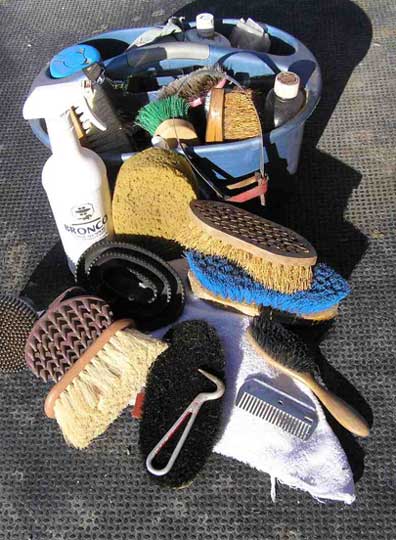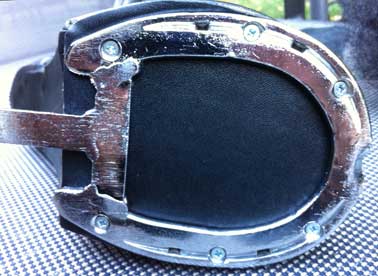
Photo by BLW (license: CC BY-SA 3.0)

Photo by BLW (license: CC BY-SA 3.0)
Grooming your pony can be a very intimate activity for both you and your pony. Moreover, it can very enjoyable for the pony to be brushed, petted, and in general have his owner's hands lightly caressing and going over his skin. This is a great activity both before and after a ponyplay session.
To groom your pony, you will typically tie or cross tie him, so I will assume for this section that your pony is trained to tying or cross tying. If not you can: learn how to tie your pony, and learn how to cross tie your pony.
Before you begin, here's some grooming equipment you want to have on hand:
It is not a bad idea to have a grooming bucket to carry and store your pony's grooming supplies. A bio-equine feed bucket, or grooming bucket are some good choices. The grooming tools can also be purchased from a bio-equine tack store (either online or on person) relatively inexpensively.
The first step is to lead you pony over to the cross ties, or alternatively tie him to a hitching post or the ring in his stall, and secure him to the ties (or ring). Once your pony is tied (if not using cross ties with quick release snaps, you should tie your pony with a quick release knot) you can start with the rubber curry comb. Start at pony's neck and slowly work your way lower, rubbing the curry comb in a circular motion on your pony. Begin gently and gauge your pony's reaction. If he likes this, you can apply more pressure with the curry - some ponies really like this and consider it like a massage. Use the curry on your pony's face with caution.

Photo by Ra Boe (license: CC BY-SA 3.0)
After you have thoroughly used the curry on your pony's body, move to the stiff brush (a good rule of thumb is to start with the stiffest brush you have and progressively move to softer brushes), but instead of using a circular motion, apply the stiff brush in quick movements, flicking the brush lightly along your pony. Again, start from the neck and work your way down adjusting the pressure you used based on the pony's reaction; some ponies like a lot of pressure, but many ponies may prefer only light flicking of the brush.
Now you can move to the body brush. With the body brush, you will want to apply smooth, constant pressure unlike the stiff brush. As with both the curry and the stiff brush, you will want to start at the pony's neck and work your way down. Apply the brush flat against the pony's skin (adjusting pressure to the pony's liking) and move in long smooth strokes.
With the brushing done, you will want to move on to your pony's mane. Whether you are combing a pony's natural mane (i.e. hair) or a mane the pony might be wearing (e.g. as a mask or part of his bridle), you will want to be gentle so as not to break the pony's hair.
After you finish the mane, you can move on the pony's tail. If you used a mane comb for bio-equines, do not use this on your pony's tail; its teeth are too fine! Now, some ponies have butt-plug tails, which while definitely fun, are not always conducive to being brushed (read: heavy brushing may result in the tail popping out of the pony's ass!). So if your pony has butt plug tail, be careful when brushing. If your pony's tail is attached to his harness or through other similar attachment, you can be a bit rougher with it and get out more of the knots. Brush the pony's tail until you can run your finger through it and not encounter much if any resistance.

Photo by cPony
If your pony wears hoofboots with horseshoes, you will want to check, and possibly pick, your pony's feet. To check your pony's feet, stand facing opposite your pony and run your hand down your pony's leg (start at the crotch if you like!) to the ankle, which you will lightly squeeze. This is a signal to your pony that you wish him to take his weight and slightly raise this foot. Now keeping your hold of the pony's ankle life up his foot (not too high since he only has two legs, and if you're doing this he has on boots that may be hard enough to balance in) and look at the space within the horseshoe (this is where mud and such will accumulate). If there is dirt, mud, etc. there, gently scrape it away with the hoof pick being careful not damage the pony's hooves (the boot were most likely quite expensive - no sense in damaging it). You can also use a towel here to clean up the bottom of the hoof.
Finally, use the soft towel to gently wipe down you pony. Now you're done and have a clean (and grateful) pony!